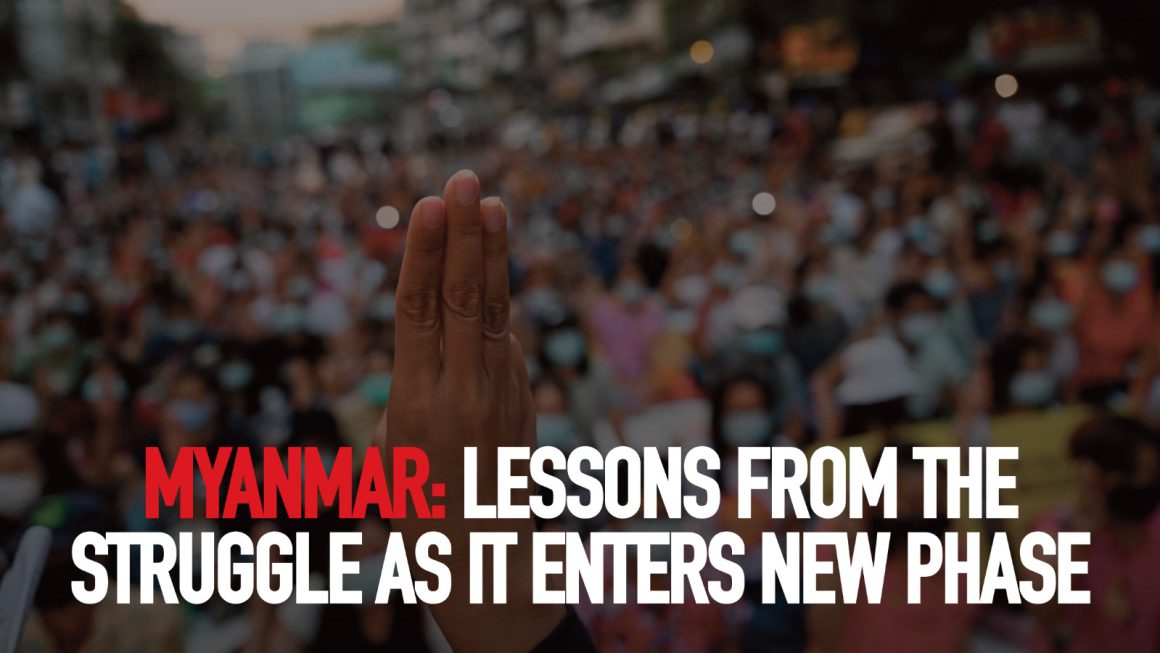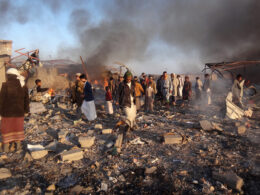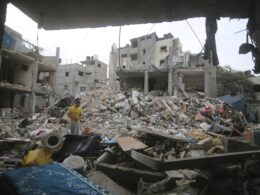By Rob Jones
A graphic example of the current situation in Myanmar was given the other day, when while speaking to one of our correspondents, a bomb exploded in the background. Now nearly four months after the military announced their take-over on 1 February, the country has never been closer to what some commentators call ‘a failed state’.
Despite the overwhelming superiority of weaponry in the hands of the military, the heroic Myanmar masses are continuing to resist the takeover.
Fighting is spreading across the whole country as local, mainly ethnic-based militias take on the might of the military using air guns, traditional firearms and homemade bombs in Kayah state, Chin State, Sagaing, Magwe and Mandalay regions.
At least 739 people have been killed by the military so far — dozens of them children. According to the ‘Assistance Association for Political Prisoners’ over 3,300 have been arrested with at least 1,000 more with arrest warrants issued against them. 20 of those face the death sentence. The regime uses torture, many female detainees are sexually assaulted. Most of those who die are detainees who are murdered by the military during interrogation. There are many cases of people arrested in good health, but all that remains the next morning is their dead body.
Typical is the situation in the Sagaing region. Villagers are fleeing their home in the Kani township as what locals call the “terrorist military” have taken over the area and are committing war crimes. There are frequent clashes between local defence forces and the military — explosions are common. Police shot a soldier, who later died after he was found sexually attacking women bathing in the local canal.
Economic disaster
The economy has been wrecked by the military takeover. For some years it had been growing, in part because multinationals began using the country as a cheaper labour source than China. Now the World Bank predicts a collapse by 10% of GDP in 2021, while a group of private economists warn the drop could even be twice as bad.
Numbers employed in the garment sector were over 700,000 a year ago and are now about half of that. Covid, the economic chaos caused by the military takeover and a decline in international orders have been compounded as protesters attacked several factories because of their links to the Chinese regime, which is broadly seen to be supporting the military.
The banking system has been more or less paralysed since the coup with many branches still closed and ATM withdrawals severely restricted. With banks unable to process import and export documents, foreign trade has practically ceased. As many workers have not been able to receive their pay for April, there has been a flow of workers back to rural areas where they can at least live with relatives.
It is also estimated that 3–400,000 jobs have been lost in the construction sector. The United Nations Development Programme predicts that due to the impact of Covid and the military takeover, nearly half of Myanmar’s population will be living in poverty by 2022.
As one worker writing on #MyanmarLabourNews puts it: “I am angry at people who are in power. My factory is closed. I have no job. How can I cope with two kids? I am having to give a blanket to my son and daughter who are sleeping in the corner of my house after eating rice… Millions of workers across the country have become unemployed as foreign investments have been shut down after military council power”.
Vindictive acts by the Tatmadaw
As if this wasn’t bad enough the military are waging war against anyone who opposes them in the workplaces. According to the Myanmar teachers federation, over 125,000 teachers have been suspended due to their participation in protests. Doctors and nurses who were among the first to resist the coup with the call to establish the Civil Disobedience Movement have continued their strike. Practically the whole state healthcare system, which accounts for 80% of all treatments provided, is no longer functioning. Medical staff initially tried to establish alternative health care facilities away from the control of the military, but have found themselves attacked by the army. Hundreds have been arrested or have warrants issued against them.
Covid 19, of course, is now likely to raise its ugly head again — as the state response, including a vaccination programme, collapsed after the coup. Vaccines have only been distributed independently and in relatively small numbers by some of the ethnic authorities.
There are, of course, many worker and trade union activists who have been arrested or are under threat. Perhaps the best known is the leader of the ‘Solidarity of Trade Unions in Myanmar’ Daw Myo Aye. She is reportedly being held in the notorious Insein prison, known as Myanmar’s “darkest hell-hole” for its inhumane conditions. As she suffers from a serious kidney condition there are real concerns for her health.
Fighting the military
The key is the struggle against the military. There are many valuable lessons from the past and present. Under the Franco regime in Spain, the military dictatorship of Pinochet in Chile or the apartheid regime in South Africa, the struggle had elements of armed resistance to some degree. But in all of these cases they acted as a diversion from the real battle. The critical, decisive role was played by the organized working class. These authoritarian regimes were brought to their knees by building democratic fighting trade unions, political organisations and general strikes.
Many in Myanmar talk of the current struggle as being a struggle against fascism. The People’s Defence Force (PDF) set up by the National Unity Government (NUG) even uses a red banner with a white star as its flag — this was used by the anti-fascist resistance in World War 2. The equation of the military with fascism is perfectly understandable given the widespread brutality of the regime.
Contrary, however, to classical fascism, the military does not have a mass base of demoralized and impoverished petty bourgeois — on the contrary, the opposition to the coup has widespread support amongst those sections of society that would in the past have been the social base for fascism.
The regime is isolated, its main social base — the army and police, those parts of the economy it controls as well as a section of international and national capital — is not strong enough to withstand outright resistance if a clear lead was to be given by the working class. And as has already happened in Kani township and elsewhere conflicts between the army and police can open up, undermining even further support for the Tatmadaw.
Lessons from the antifascist struggle
Anti-fascism has a long and heroic tradition in Myanmar — tracing back to the Anti-Fascist Organisation that fought Japanese occupation during WW2, and then the Anti-Fascist People’s Freedom League (AFPFL) at one time led by Aung San, father of Aung San Suu Kyi, until his assassination in 1947. There are, however, also lessons to be learnt from that period.
In August 1917, in the midst of the Russian Revolution, reaction attempted a military coup against the bourgeois Provisional government (which resulted from the February revolution) that would, if successful, have resulted in a regime at least as bad, and probably much worse than that of the Tatmadaw. Reaction was defeated, opening the road to the successful October revolution by working class action led by the Bolshevik Party of Lenin and Trotsky. While the Bolsheviks and workers fought against the July coup, they, in the words of Leon Trotsky, considered “it was not a case of defending the [Provisional] government, but of defending the revolution”.
The defeat of the reactionary generals and Cossacks was a result not primarily of military action, but of political and social interaction between the workers of Petrograd and the soldier masses, mainly from a peasant background. That was only possible because the Bolsheviks made a class appeal to the soldiers with the promise of ‘bread, peace and land’. Another key policy of the Bolsheviks was to grant the right of self determination to national minorities.
The approach of the AFPFL, including that of the Burmese Communist Party, however was inspired not by the approach of Lenin and Trotsky, but that of Stalin and Mao. They preferred to form an alliance with sections of the bourgeoisie, even in the case of Aung San with Japanese imperialism. Working class independence was sacrificed.
As a result, as independence became possible following the collapse of Japanese imperialism after WW2, power was transferred to the weak Burmese bourgeoisie. They proved incapable of establishing a stable capitalist society — unable to complete the tasks of the ‘bourgeois democratic revolution’, such as land reform, bourgeois parliamentarianism, unity of the nation state or of standing up to the imperialist powers. Guerrilla war swept the country.
With the victory of the Chinese revolution in 1949 which, unlike the Russian revolution, was deformed from the very beginning with a one party totalitarian state resting on elements of a Stalinist planned economy, it was inevitable that the Burmese officer caste saw this as an example. While foreign capital was nationalised and national capital expropriated, a one-party state was established. In the name of “Burmese-Buddhist socialism” the masses were deprived of democratic rights, ethnic groups deprived of the right to self determination. As the Chinese regime moved to restore capitalism, Burma too moved in that direction, leaving it now dominated by Chinese imperialism.
These may be historical examples, but they remain as valid today when developing a strategy to defeat the Tatmadaw.
No trust in the NLD
The NLD (National League For Democracy), led by Aung San Suu Kyi has demonstrated whilst in power that it can not be trusted. The 2008 Constitution was drawn up in such a way as to ensure the continued dominance of the military regime. From the start the NLD has accepted a compromise with the Tatmadaw, using authoritarian laws to restrict journalists’ rights and justified the use of what the United Nations termed as “intent of genocide” against the Rohingya population. Indeed, according to the group “Justice for Myanmar” the NLD government was even purchasing internet spyware for use by the military. The situation facing workers was no better. Unions still lacked the full freedom to organize, whilst labour leaders were sued and imprisoned. The multinationals used the resulting low wages and poor conditions to boost their profits.
The NLD’s strategy for opposing the military takeover by appealing to capitalist international bodies is doomed to failure. The hopes that ASEAN (Association of Southeast Asian Nations) at its summit would take decisive action were dashed when it invited coup leader Min Aung Hliang to attend. At best it declared that violence should cease, but called for “constructive dialogue among all parties” and “mediation” — once again leaving the military with a key role to play. ASEAN did not even endorse the call for the release of all political prisoners to avoid upsetting Min Aung Hliang. The United Nations has since endorsed this position.
The position of Chinese and Russian imperialism in supporting the military is clear. Japan has called for the negotiation channels with the military to be left open. The Western imperialist powers hypocritically declare that they are in favour of sanctions on trade, investment and military exchanges. Sanctions against individuals are empty gestures, whilst international companies continue to do business with the military.
The US oil company Chevron is frantically lobbying to ensure no sanctions are placed on its dealings with the Tatmadaw, whilst the French Total is running offshore accounts to ensure oil and gas revenues continue to reach the military council. The recent declaration that they will no longer pay dividends to the military means nothing as the Military Council will still get the income from the sales of gas and oil.
Need for international workers’ solidarity
The leadership of the international trade union movement has campaigned for sanctions, but has relied on lobbying the management of the “Brands” to cease ordering from Myanmar factories. In March, H&M and Primark amongst others announced they would not source materials from Myanmar due to instability, but they have already resumed orders. Their profits based on the exploitation of Myanmar’s low wages are more important than human rights. The hypocrisy of companies such as Primark is incredible. Over a thousand workers producing garments for Primark in Myanmar were locked into their factory by supervisors in early February to prevent them joining the anti-coup protests.
These examples demonstrate a flawed tactic used by the international trade unions. They rely on agreement with the boards of multinationals rather than genuine international workers’ solidarity. Dockers in Italy have recently refused to transport arms for use in Yemen’s civil war or Israel’s attacks on the Palestinians. Railway workers in Australia have boycotted the transport of goods for use by the Myanmar military. These examples show what would be possible if the international trade unions waged a real campaign to boycott the Myanmar military — such blacking could be directed so they do not cause a loss of jobs for textile workers but stop the supply of arms and repressive equipment, or revenues from oil and gas reaching the military.
Illusions in national unity government declining
Particularly among the youth, doubts are now growing about the role of the self-appointed National Unity Government (NUG). When it was formed it made much of the fact it had learned from the previous NLD government and was now committed to “federalism” and would involve all the ethnic groups. But those it has appointed are usually academics or individuals who are not representative of the ethnic population. While it contains no representative of the Rohinjyas, it does contain those who were complicit in justifying the massacres of Rohingya people. The working class and youth — the backbone of the struggle — are barely represented. Workers and all participating in the struggle need independent organising, with their own political party rather than tail-ending these self-appointed leaders. Only in this way can a revolutionary programme be implemented that can break the might of the military and end imperialist exploitation.
Others complain that the government has appointed ministers and deputy ministers who act as if they are members of a normal government working in normal conditions. The NUG talks about the need to establish a federal army linking the different ethnic groups but is, at best, slow in providing resources or weapons. In some areas it even tries to establish alternative forces to those that already exist. This is leading to independent action by different groups as explained by the spokesman of the Chinland Defence Force: “We do not see this as an NLD battle. It has nothing to do with the party. We are not fighting for the NUG. We are working for the good of the whole country”.
Whilst some defence forces are close to the people, others have a poor record. Influenced by Maoist policies and methods they have a top down, militarised structure. Others have relied on the drugs trade to finance their activities. This raises an unpleasant perspective of a repeat in Myanmar of the Syrian scenario, which is increasingly likely if the working class does not take the lead.
In Syria, as part of the wave of revolutionary movements that spread across North Africa and the Middle East, a popular uprising in part against poverty and unemployment, and against the authoritarian regime of Assad degenerated into a sectarian civil war. Different armed groups, often backed by outside forces such as Iran or Turkey, and of course Western imperialism failed to dislodge the authoritarian regime of Assad, which has the backing and military support of Russia. About half a million Syrians have been killed and many more become refugees. Similarly, Myanmar is an arena for the cold war between Chinese and US imperialism.
How Can the Military be Defeated?
It is understandable and correct that many are taking up arms to combat the Tatmadaw, with a stepping up of guerilla struggle particularly in those areas where the ethnic forces have a base. Given the anger of the population and the army’s lack of a social base such a struggle can go further than that in the past. But the Tatmadaw has access to high tech equipment and has decades of experience in combating guerilla struggle. Hi-tech Russian aircraft are used to bomb the ethnic areas. Even so, if it looks like the military is losing control of the country, its allies, Russia and China could step in with support, as Russia has already done with the Assad regime in Syria.
Workers and youth must have the right to self defence. It should be organized not by relying on the NUG or heads of the ethnic forces who are motivated more by their own interests, but controlled democratically by workers, youth and the poor in their own interests.
However, the defeat of the Tatmadaw needs a working class-led political campaign that guarantees the right of self-determination to all national minorities, the redistribution of land to all poor farmers and their families, proper wages and trade union rights to workers. This would forge a clear unity between the workers, poor farmers and ethnic minorities in this struggle.
The NUG/NLD, notwithstanding their recent turn to a more radical position under the pressure of the mass struggle against the military, remains pro-capitalist and will not take measures either against the multinational companies who exploit Myanmar’s workers nor to undermine the economic interests of the army by taking the companies it controls into public ownership under workers’ control. Most likely, they will also search a new compromise with the military or underestimate the threat from the generals. The struggle against the generals also immediately becomes a struggle against the economic system, with Myanmar capitalism being under the control of the top officers.
If the working class and poor in Myanmar was to organize around such a programme at the head of the struggle, it would have tremendous support amongst the global working class and gain real, genuine international solidarity. It would act as a tremendous beacon to the working class of China and Russia undermining the power of even these authoritarian regimes to intervene.
If the working class of Myanmar was to go on the offensive, by escalating the struggle with an indefinite general strike combined with democratic controlled armed defence and a policy directed to win over or neutralise soldiers. In this way, it could force the disbanding of the Tatmadaw, opening the way for a revolutionary constituent assembly.
The Struggle for democracy
There is a certain history of “constituent assemblies” in Burma/Myanmar. In 1947, the AFPFL under the leadership of Aung San, introduced a new Constitution drawn up by “experts”, which was supposed to be modelled on a combination of that of Stalin’s USSR and the new Federal Republic of Yugoslavia. It neither challenged the rule of capital nor ensured that workers and poor families would have democratic control over society.
Following the “8888” Revolution (in 1988), the military was forced to establish a “National Convention” made up mainly of hand-picked delegates to draw up a new Constitution. This resulted in a Constitution that protected the rights of the military.
In the modern world, the ruling elite sometimes use the idea of a constituent assembly to divert a revolutionary movement into constitutional battles. This happened as the Franco regime collapsed in Spain, and at the end of Pinochet’s dictatorship in Chile.
In 2019, again in Chile, the government tried to derail the revolutionary uprising by proposing a constitutional assembly in which delegates elected from the current political parties would propose changes. This backfired when the masses demanded that delegates should be elected directly — as a result a significant number of left and independent representatives of mass protest movements were elected.
But a revolutionary constituent assembly would be different. Delegates should be elected to represent all those currently involved in resisting the Tatmadaw — workers, medical workers, students, youth, poor farmers and the ethnic minorities should all send their own representatives.
Only in such a way, with the working class and independent trade unions taking the lead, can a genuine democratic system without any compromise with the military be established. A new constitution, and a new government that would result would be one that actually represents the democratic, social, economic and national rights of the workers, poor farmers and youth in Myanmar, in a genuinely free and democratic socialist Myanmar.












